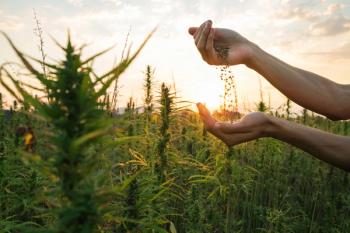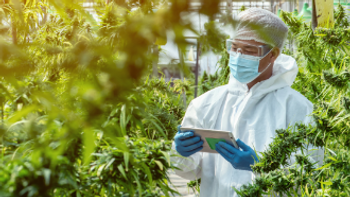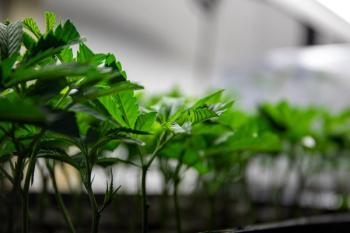
Cannabis Science and Technology
- July/August 2024
- Volume 7
- Issue 4
- Pages: 14-18
Lighting Penetration in Indoor Cannabis Cultivation

A look at how some cultivation methods are used to increase plant canopy penetrationfor indoor cannabis cultivation, increasing crop size while enhancing cannabinoid, terpene, and flavonoid production.
In indoor cannabis cultivation, increasing lighting penetration is crucial to maximize yield and ensure quality and consistent phytochemical content. Many factors influence how light penetrates the canopy, impacting photosynthesis and overall plant growth. We discuss methods to increase plant canopy penetration for indoor cannabis cultivation, increasing crop size while enhancing cannabinoid, terpene, and flavonoid production.
Shortcomings of Lighting in Indoor Horticulture
In the realm of cannabis cultivation, sunlight remains unmatched in its ability to penetrate plant canopies effectively. Despite advancements in indoor lighting technologies, these systems fail to achieve the same depth and uniformity of light penetration that sunlight provides. The inadequacies of lighting penetration in indoor horticulture can be attributed to deficiencies in lighting intensity, spectrum, and distribution, as well as thermal management of the grow environment. Moreover, certain plant functions, such as tropisms, photoreceptor and pigment protein saturation and activation, adversely influence light penetration, affecting plant health in indoor cannabis operations. For the purposes of this discussion, this paper addresses the use of full-spectrum light emitting diodes (LEDs) lighting in indoor grow operations. Although the term “full-spectrum” is used, LED lighting systems fall short of delivering the true full spectrum of light delivered by the sun.
Lighting Intensity
Lighting intensity is a critical factor that directly influences photosynthesis, impacting yield and phytochemical composition in cannabis cultivation. Cannabis plants require a specific light intensity range for optimal growth. Insufficient lighting can stunt growth, reduce biomass, and accelerate leaf shedding by impairing photosynthesis and hormone signaling. Excessive light intensity can cause photoinhibition, which damages the photosynthetic apparatus and induces a stress response. Interestingly, these stress responses are not always detrimental; in some cases, they can lead to the enhanced production of secondary metabolites. Since these responses occur at the subcellular level, they present significant challenges for study and analysis (1).
Lighting intensity, quantified in micromoles per square meter per second (µmol/m²/s), is a fundamental metric in cannabis cultivation. During the vegetative growth phase, cannabis plants typically require light intensities ranging from 400-600 µmol/m²/s. This requirement increases to approximately 600-900 µmol/m²/s during the flowering stage to support flower development and resin production.For reference, sunlight within the Photosynthetically Active Radiation (PAR) spectrum of 400-700 nanometers (nm), strikes the Earth at an intensity of around 2000 µmol/m2/s.
In contrast, LED lighting seldom achieves intensities exceeding 1000 µmol/m2/s at the plant canopy, and when it does, the lighting footprint provided is very limited. Several factors influence LED lighting performance, including the efficacy of the LEDs, typically measured in lumens per Watt (lm/W), and the ability to control lighting output to achieve uniform coverage with minimal waste. Although the efficacy of LEDs is improving, the theoretical maximum for full-spectrum LEDs stands at 300-400 lumens per Watt (2).
Incorrect lighting placement is a common issue in cultivation. LED lighting has an output that is either too wide causing “spill” or wasted light that doesn’t strike the plant canopy, or too narrow, providing adequate lighting to only a limited portion of the plant canopy. The height at which lights are mounted is a critical factor as well, especially with horticultural fixtures that were designed to be mounted very close to the plant canopy. For instance, one manufacturer recommends a mounting height of 8 in above the plant tops. If this distance is doubled, the light intensity, and therefore photon delivery, decreases by 75% (refer to the Inverse Square Law for Lighting). This demonstrates how small variations of just a few inches can significantly change lighting delivery.
Light Spectrum
“Lighting spectrum” refers to the wavelengths emitted by a light source, encompassing the visible light spectrum and extending into the ultra-violet (UV) and infrared (IR) regions. Blue light (400-500 nm) is essential for vegetative growth, regulating stomatal opening and chlorophyll synthesis. Red light (600-700nm) is pivotal in driving photosynthesis and influencing flowering and photomorphology. Far Red light (700-800nm) increases growth and helps to regulate photoperiod. Amber light peaks at 620 nm and provides protective properties, which we identify later.
Despite the high configurability of LED spectrum delivery by manufacturers, their ability to compete with natural sunlight in terms of intensity and spectrum remains constrained by high costs and current technological limitations. Nevertheless, LED technology has significantly advanced, offering superior capabilities that far outweigh those of more traditional horticultural lighting solutions, such as High Pressure Sodium (HPS), Metal Halide (MH) including Ceramic Metal Halide (CMH), and fluorescent technologies. It is now common knowledge that LED lighting produces higher quality cannabis in greater yields than the industry’s previously adopted lighting solutions.
The advantages of LED lighting stem from its ability to tailor the light spectrum to the specific needs of cannabis plants at different growth stages. This generally requires a combination of broad-spectrum and discrete frequencies to create an optimal light recipe for cannabis growth. This means some frequencies are underserved while some frequencies may provide too much light. The underserved frequencies lack the power to penetrate deep into the canopy and maximize yields. On the other hand, the overabundant frequencies can lead to photoreceptor and pigment saturation, causing plants to activate protective mechanisms or suffer from growth and quality issues.
Light Saturation
An overabundance of light can lead to the saturation of photoreactive plant elements, which play vital roles in growth, development and stress responses of plants. These elements include pigments such as chlorophyll, carotenoids, anthocyanins and flavonoids, as well as photoreceptors like phytochromes, cryptochromes, phytotropins and UVR8.
Pigments
Chlorophyll, the most crucial pigment in plants, is essential for photosynthesis, where it converts light energy into chemical energy, transforming water (H2O) and carbon dioxide (CO2) into oxygen (O2) and glucose (C6H12O6). Excessive light can saturate chlorophyll, causing growth to plateau and potentially damage leaves. Photoinhibition results when the plant's photosynthetic machinery is overwhelmed, decreasing photosynthesis efficiency and energy production. Photoinhibition can also generate reactive oxygen species (ROS), including free radicals and peroxides, which may oxidize vital cellular components like proteins, lipids, and nucleic acids, leading to significant cellular damage or death (4).
Carotenoids are critical for protecting chlorophyll from photooxidation and facilitating non-photochemical quenching—a process that turns excess light energy into heat. If this pigment experiences light saturation, carotenoids can undergo photobleaching. This degradation results in the loss of their color, light absorption capabilities, and antioxidant functions (5).
Anthocyanins absorb blue-green and ultraviolet light, functioning as photoreceptive agents to mitigate cellular damage. Additionally, they also produce red and blue hues in plants. However, when these pigments become saturated, their protective properties diminish, potentially leading to altered or faded coloration within the plant tissues (6).
Flavonoids, a diverse group of phytonutrients, encompass various pigments including anthocyanins, and are renowned for their antioxidant properties. They play a vital role in neutralizing ROS and protecting plant cells from oxidative stress. Prolonged exposure to excessive light can cause flavonoids to become saturated and could damage enzymatic pathways. This may also disrupt their structural integrity and functionality thus affecting the overall plant health and resilience.
Photoreceptors
Phytochromes are photoreceptors that are sensitive to red and far-red receptors. Phytochromes help regulate processes such as seed germination, stem elongation, leaf expansion, and the timing of flowering in response to changes in light conditions. During seed germination, where they detect light quality and quantity, which is crucial for breaking seed dormancy and initiating growth. They are also able to detect the light environment, distinguishing between shaded and full light conditions. Furthermore, phytochromes are integral in photoperiodism, influencing the timing of flowering based on day length.
Cryptochromes are photoreceptors that are sensitive to blue-light and to ultraviolet-A (UV-A) radiation.They control several functions, including seedling development, flowering time, and circadian rhythms. They play a crucial role in enabling plants to gauge the overall quality of light, important for growth and development.
Phototropins, another group of blue-light responsive photoreceptors are primarily involved in mediating phototropism—the growth of plant organs towards or away from light. They influence chloroplast movement, stomatal opening, and possibly light-induced water uptake mechanisms.
The saturation of these photoreceptors can lead to a range of issues, from altered growth patterns and developmental timing to reduced photosynthetic efficiency and stress responses.
Solutions to Maximize Canopy Penetration
The following discusses the importance of maintaining high photosynthetic photon flux density (PPFD) levels for optimal plant growth and details strategies to maximize light penetration within a plant canopy effectively. It highlights various methods to ensure plants receive sufficient light without risking light saturation or damage, essential for achieving high yields and superior phytochemical content in cannabis.
Manage Lighting Intensity
High PPFD levels ensure that plants receive adequate light for maximum photosynthetic activity, leading to higher yields, and higher quality phytochemical content. However, maintaining an optimal PPFD without causing light saturation or damage is crucial to plant function.
Here are the primary methods for maximizing canopy penetration without harming plants:
- Use LED Luminaires: LEDs can increase penetration due to their lower waste heat output, allowing them to be placed closer to the plant canopy without causing heat stress. If purchasing new lighting, make sure you have enough lights to cover your crop correctly. Adjust the power settings to meet the PAR requirements for all stages of growth. Purchasing LED fixtures that utilize Total Internal Reflective lensing will further increase PPFD and penetration with minimal wasted light.
- Optimize Light Placement and Mounting Height: Arrange your lights to maximize coverage over your canopy with minimal spill and wasted light. Use enough light fixtures to cover your crop, then increase your luminaire density until PAR values required by your plants for their specific stage of growth are met. Use an LED-specific extended PAR lighting meter (400-750 nm) to verify accuracy of your setup.
- Use Under Lighting: Not a common practice but worth mentioning is the use of under-lighting specifically designed to illuminate plants from below is worth considering. Though a costly endeavor, it may prove advantageous for high-end boutique cultivation operations. Great care must be taken to ensure these lighting fixtures are built for the task: they should be water and dust proof, possess excellent thermal management to prevent LEDs from overheating, and include robust electrical protection.
- Adjust Lighting Intensity as Plants Grow: Increasing light intensity gradually as plants mature can maintain highest penetration possible while minimizing light stress. There are several methods to accomplish this:
1. Some LED fixtures have dimming capabilities, either manually adjusted or automatically tuned via various equipment and applications.
2. Traditionally, non-LED lighting technologies have required manual adjustment of height for each light. This can become quite a chore if the operation uses many lights.
3. Automated light movers can be used for height adjustment, but their use is generally not recommended due to their high cost and potential maintenance challenges.
4. To accomplish this task with minimal capital and operational (labor) costs, it is highly recommended to place lights at a height far enough above the plants to cause them to “stretch” into the lighting. As plants stretch towards the light source, PAR values will increase. Once plants reach their maturity height, the lights may be raised or lowered to tune the PAR values. After the first few crops run in your facility, with known genetics and specific light fixtures, growers can usually place lights and never have to touch them again during the flowering stages.
- Use Reflective Materials: Use reflective surfaces to bounce light under and around plant canopies. Flat white paint covering walls and flooring is inexpensive and helps spread light evenly. For those using grow trays, some manufacturers build them in flat white for this purpose.
- Control Plant Density and Canopy Management: Regularly tend plants to manage canopy density and branch positioning. Techniques like topping, low-stress training (LST), and defoliation can help create a more open canopy, allowing light to penetrate deeper. This not only improves light penetration but also air circulation.
- Monitor and Adjust Environment: Ensure temperature, humidity, and CO2 levels are optimized. Waste heat (energy converted to heat instead of light) can increase leaf temperature, so adequate ventilation and air conditioning may be necessary to keep temperatures within an ideal range (typically 70-85° F during the light period). Monitor this by ensuring proper Vapor Pressure Deficit (VPD) is maintained (7).
Manage Lighting Spectrum
Using these spectrum strategies, you can further improve light penetration in an indoor cannabis operation, while minimizing the risk of light-induced stress or damage due to saturation.
- Use Full-Spectrum LEDs: Full-spectrum LED lights attempt to replicate natural sunlight and provide a balanced spectrum that includes wavelengths that target the known photoreceptors and pigments. Although full spectrum LEDs cannot entirely replicate sunlight, they offer other advantages. These LEDs, which consist of blue base LED coated with an excitable phosphor material, provide smooth and continuous transitions across an extended PAR curve (usually 425-750 nm). Leaving no gaps in spectrum coverage is extremely beneficial to plants, particularly since most photobiologists agree that science is far from fully understanding a plant’s use of light.
- Supplement with Discrete (targeted narrowband) Red and Far-Red Light for Flowering Cannabis: Adding discrete red and far-red lights can improve light penetration and stimulate deeper canopy growth due to their longer wavelengths. These wavelengths are absorbed less superficially and have fewer receptors than blue light, allowing them to reach further down into the plant, enhancing photosynthesis in lower leaves without the risk of light saturation. It is important to note that plant photosystems require only 1 or 2 blue photons to process a CO2 molecule while the red end of the spectrum requires 8-10 photons to process CO2 molecules (8).
- Make Sure Your LEDs Take Advantage of the Emerson Effect (9): By understanding and applying the Emerson Effect, cultivators can significantly improve both the efficiency of photosynthesis and the overall productivity of plant crops. The Emerson Effect is a phenomenon in photosynthesis whereby the rate of photosynthesis is significantly increased when red light (~660 nm) and far-red light (~730 nm) are provided simultaneously, compared to each light wavelength supplied alone. This effect highlights the synergistic interaction between two photosystems involved in the light-dependent reactions of photosynthesis: Photosystem I (PSI) and Photosystem II (PSII).
Conclusion
Optimizing lighting penetration in indoor cannabis cultivation is essential for maximizing yield and ensuring high-quality phytochemical content. While indoor lighting systems, particularly LEDs, offer significant advantages over traditional methods, they still face challenges in replicating the intensity and spectrum of natural sunlight. Effective strategies to enhance light penetration include proper light placement, utilizing full-spectrum LEDs, supplementing with red and far-red light, and employing reflective materials. Additionally, managing plant canopy and environmental conditions are crucial for achieving the best results. By implementing these techniques, cultivators can overcome the limitations of indoor lighting and improve both the productivity and quality of their cannabis crops.
References
- Alves, P.; Magalhães, A.; Barja, P. The phenomenon of photoinhibition of photosynthesis and its importance in reforestation. The Botanical Review, 2002, 193.
- Schubert, E. F. Solid-State Light Sources Getting Smart. Science, 2005, 308 (5726), 1274–1278.
https://doi.org/10.1126/science.1108712 - McCree, K. J. The Action Spectrum, Absorptance and Quantum Yield of Photosynthesis in Crop Plants. Agricultural Meteorology, 1971, 9, 191–216.
https://doi.org/10.1016/0002-1571(71)90022-7 - Mansoor, S.; Ali Wani, O.; Lone, J. K.; Manhas, S.; Kour, N.; Alam, P.; Ahmad, A.; Ahmad, P. Reactive Oxygen Species in Plants: From Source to Sink. Antioxidants, 2022, 11 (2), 225.
https://doi.org/10.3390/antiox11020225 - Lima-Melo, Y.; Alencar, V. T. C. B.; Lobo, A. K. M.; Sousa, R. H. V.; Tikkanen, M.; Aro, E.-M.; Silveira, J. A. G.; Gollan, P. J. Photoinhibition of Photosystem I Provides Oxidative Protection during Imbalanced Photosynthetic Electron Transport in Arabidopsis Thaliana. Frontiers in Plant Science, 2019, 10.
https://doi.org/10.3389/fpls.2019.00916 - Hildenbrand, Z. L.; Mendoza-Dickey, H.; Manes, R. Enhancing Anthocyanin Levels in Cannabis: Environmental Factors at Play. Cannabis Science and Technology, 2024, 7(2), 14–17.
- Mendoza-Dickey, H., Manes, R., & Hildenbrand, Z. L. Intensity and spectrum: The role of lighting in vapor pressure deficit. Cannabis Science and Technology, 2023, 6(6), 22-30.
- Gates, D. M. Biophysical Ecology; Springer Nature, 1980.
https://doi.org/10.1007/978-1-4612-6024-0 - EMERSON, R. Dependence of yield of photo-synthesis in long wave red on wavelength and intensity of supplementary light. Science, 1957, 125:746.
About the Columnist
Dr. Zacariah Hildenbrand is a research Professor at the University of Texas at El Paso, the principal founder of Inform Environmental, a partner of Medusa Analytical, and is a director of the Curtis Mathes Corporation (OTC:CMCZ). Direct correspondence to:
About the Guest Co-Author
Hannia Mendoza -Dickey has a MS degree in Chemistry and is the founder of Green Matter Consulting.
About the Guest Co-Author
Robert Manes is the CEO and CTO of the publicly-traded Curtis Mathes Corporation, where he specializes in the creation and manufacture of frequency-specific lighting for horticulture and phototherapy purposes.
How to Cite This Article
Hildenbrand, Z., Mendoza-Dickey, H., Manes, R., Lighting Penetration in Indoor Cannabis Cultivation, Cannabis Science and Technology, 2024, 7(4), 14-18.
Articles in this issue
over 1 year ago
Calibration Science, Part V: Spotting OutliersNewsletter
Unlock the latest breakthroughs in cannabis science—subscribe now to get expert insights, research, and industry updates delivered to your inbox.



